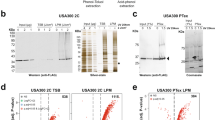Abstract
Response regulators are terminal ends of bacterial two-component systems that undergo extensive structural reorganization in response to phosphoryl transfer from their cognate histidine kinases. The response regulator encoded by the gene sma0114 of Sinorhizobium meliloti is a part of a unique class of two-component systems that employ HWE histidine kinases. The distinct features of Sma0114 include a PFxFATGY motif that houses the conserved threonine in the “Y–T coupling” conformational switch which mediates output response through downstream protein–protein interactions, and the replacement of the conserved phenylalanine/tyrosine in Y–T coupling by a leucine. Here we present 1H, 15N, and 13C NMR assignments for Sma0114. We identify the secondary structure of the protein based on TALOS chemical shift analysis, 3JHNHα coupling constants and hydrogen–deuterium exchange. The secondary structure determined by NMR is in good agreement with that predicted from the sequence. Both methods suggest that Sma0114 differs from standard CheY-like folds by missing the fourth α-helix. Our initial NMR characterization of Sma0114 paves the way to a full investigation of the structure and dynamics of this response regulator.


Similar content being viewed by others
References
Bryson K, McGuffin LJ, Marsden RL, Ward JJ, Sodhi JS, Jones DT (2005) Protein structure prediction servers at University College London. Nucleic Acids Res 33:W36–W38
Case DA, Dyson HJ, Wright PE (1994) Use of chemical shifts and coupling constants in nuclear magnetic resonance structural studies on peptides and proteins. Methods Enzymol 239:392–416
Cavanagh J, Fairbrother WJ, Palmer AG III, Skelton NJ (2006). Protein NMR spectroscopy principles and practice, 2nd edn. Elsevier Inc., Amsterdam
Cornilescu G, Delaglio F, Bax A (1999) Protein backbone angle restraints from searching a database for chemical shift and sequence homology. J Biomol NMR 13:289–302
Gao R, Stock AM (2010) Molecular strategies for phosphorylation-mediated regulation of response regulator activity. Curr Opin Microbiol 13:160–167
Karniol B, Vierstra RD (2004) The HWE histidine kinases, a new family of bacterial two-component sensor kinases with potentially diverse roles in environmental signaling. J Bacteriol 186:445–453
Laub MT, Goulian M (2007) Specificity in two-component signal transduction pathways. Annu Rev Genet 41:121–145
Stock AM, Guhaniyogi J (2006) A new perspective on response regulator activation. J Bacteriol 188:7328–7330
Stock JB, Lukat GS, Stock AM (1991) Bacterial chemotaxis and the molecular logic of intracellular signal transduction networks. Annu Rev Biophys Biophys Chem 20:109–136
Stock AM, Robinson VL, Goudreau PN (2000) Two-component signal transduction. Ann Rev Biochem 69:183–215
Vuister G, Bax A (1993) Quantitative J correlation: a new approach for measuring homonuclear three-bond J (HNH.alpha.) coupling constants in 15N-enriched proteins. J Am Chem Soc 115:7772–7777
Wishart DS, Bigam CG, Holm A, Hodges RS, Sykes BD (1995a) 1H, 13C and 15N random coil NMR chemical shifts of the common amino acids. I. Investigations of nearest-neighbor effects. J Biomol NMR 5:67–81
Wishart DS, Bigam CG, Yao J, Abildgaard F, Dyson HJ, Oldfield E, Markley JL, Sykes BD (1995b) 1H, 13C and 15N chemical shift referencing in biomolecular NMR. J Biomol NMR 6:135–140
Acknowledgments
This work was supported by a grant from the UConn Research Foundation (UCRF) to A.T.A. and D.J.G. and by DOE grants (DE-FG02-01ER15175 and DE-FG02-06ER15805) to D.J.G.
Author information
Authors and Affiliations
Corresponding authors
Rights and permissions
About this article
Cite this article
Sheftic, S.R., Garcia, P.P., Robinson, V.L. et al. NMR assignments for the Sinorhizobium meliloti response regulator Sma0114. Biomol NMR Assign 5, 55–58 (2011). https://doi.org/10.1007/s12104-010-9266-1
Received:
Accepted:
Published:
Issue Date:
DOI: https://doi.org/10.1007/s12104-010-9266-1




